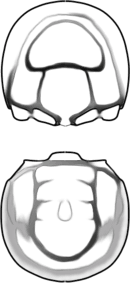Condylopygidae
The Condylopygidae are a family of very small trilobites, that lived during the Middle Cambrian, and has been found in Canada (Newfoundland and Nova Scotia), the Czech Republic, Germany, France, Spain, England, Wales, Sweden, and the Russian Federation (Siberia). They uniquely differ from all other Agnostina in having the frontal lobe of the central raised area of the headshield (or glabella) wider than the rear lobe. The Condylopygidae are the only family assigned to the Condylopygoidea superfamily.
| Condylopygidae | |
|---|---|
 | |
| linedrawing of Condylopyge cf regia[1] | |
| Scientific classification | |
| Kingdom: | |
| Phylum: | |
| Class: | |
| Order: | |
| Suborder: | Agnostina |
| Superfamily: | Condylopygoidea Raymond, 1913 |
| Family: | Condylopygidae Raymond, 1913 |
| genera | |
Taxonomy
The Condylopygoidea are a small and isolated branch in the Agnostina suborder. It occurs approximately at the same moment in time as the Peronopsidae, the earliest representatives of the main branch of the Agnostina. One species, Peronopsis palmadon, is intermediate between Peronopsidae and Condylopygidae, but it is not clear whether P. palmadon is ancestral to the Condylopigidae, a regression towards ancestral characters or an example of parallel evolution.[2]
Description

Like all Agnostida, members of the Condylopygidae are diminutive, with the headshield (or cephalon) and tailshield (or pygidium) of approximately the same size (or isopygous) and outline, and only two thorax segments. The characteristic sidewise expansion of the frontal lobe of the glabella, occipital structures instead of basal lobes, and a rhachis with three pairs of side lobes and a rear lobe differentiate Condylopygoidea from Agnostoidea.[3]
Key to the genera
| 1 | The frontal lobe of the glabella is wider than the rear lobe, giving the glabella a shape like a mushroom, but it does not envelop the sides of the rear lobe. The frontal lobe is never bisected along the midline.[3] → Condylopyge |
|---|---|
| - | The frontal lobe of the glabella is wider than the rear lobe, and envelops the sides of the rear lobe. The frontal lobe is often bisected along the midline.[3] → Pleuroctenium |
References
- Rushton, A.W.A.; Weidner, T. (2007). "The Middle Cambrian paradoxidid trilobite Hydrocephalus from Jämtland, central Sweden" (PDF). Acta Geologica Polonica. 57 (4): 391–401. Retrieved 30 March 2013.
- Naimark, E.B. (2012). "Hundred species of the Genus Peronopsis Hawle et Corda, 1847". Paleontological Journal. 46 (9): 945–1057. doi:10.1134/S0031030112090018.
- Whittington, H.B. et al. Part O, Treatise on Invertebrate Paleontology. Revised, Volume 1 – Trilobita – Introduction, Order Agnostida, Order Redlichiida. 1997